Gan Sun
Senior Member, IEEE
GLAM: Global-Local Variation Awareness in Mamba-based World Model
Jan 21, 2025



Abstract:Mimicking the real interaction trajectory in the inference of the world model has been shown to improve the sample efficiency of model-based reinforcement learning (MBRL) algorithms. Many methods directly use known state sequences for reasoning. However, this approach fails to enhance the quality of reasoning by capturing the subtle variation between states. Much like how humans infer trends in event development from this variation, in this work, we introduce Global-Local variation Awareness Mamba-based world model (GLAM) that improves reasoning quality by perceiving and predicting variation between states. GLAM comprises two Mambabased parallel reasoning modules, GMamba and LMamba, which focus on perceiving variation from global and local perspectives, respectively, during the reasoning process. GMamba focuses on identifying patterns of variation between states in the input sequence and leverages these patterns to enhance the prediction of future state variation. LMamba emphasizes reasoning about unknown information, such as rewards, termination signals, and visual representations, by perceiving variation in adjacent states. By integrating the strengths of the two modules, GLAM accounts for highervalue variation in environmental changes, providing the agent with more efficient imagination-based training. We demonstrate that our method outperforms existing methods in normalized human scores on the Atari 100k benchmark.
Novel Object Synthesis via Adaptive Text-Image Harmony
Oct 28, 2024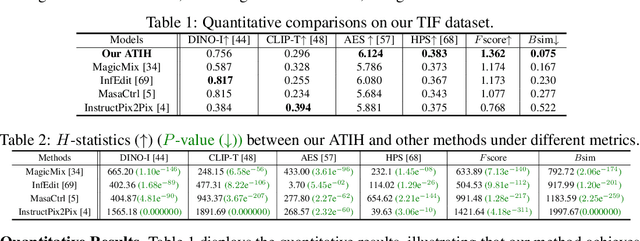
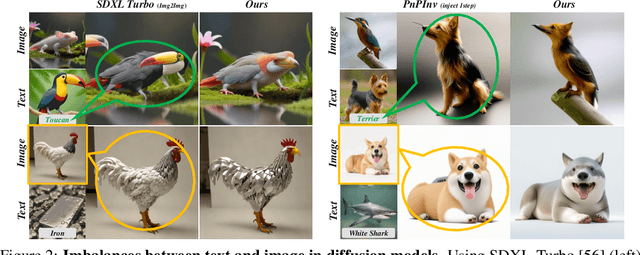
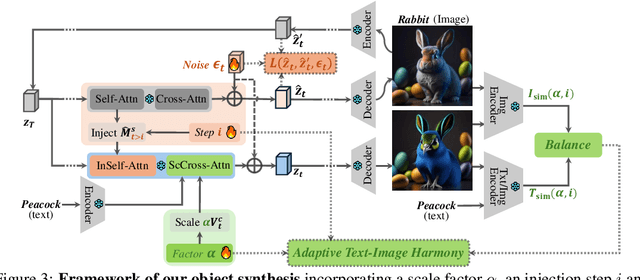
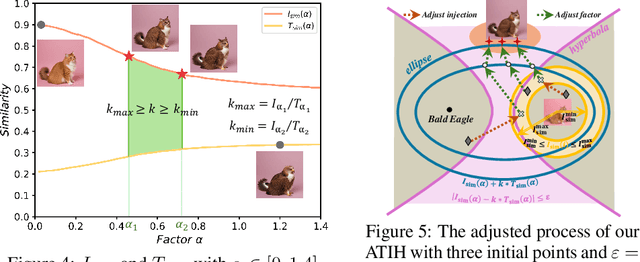
Abstract:In this paper, we study an object synthesis task that combines an object text with an object image to create a new object image. However, most diffusion models struggle with this task, \textit{i.e.}, often generating an object that predominantly reflects either the text or the image due to an imbalance between their inputs. To address this issue, we propose a simple yet effective method called Adaptive Text-Image Harmony (ATIH) to generate novel and surprising objects. First, we introduce a scale factor and an injection step to balance text and image features in cross-attention and to preserve image information in self-attention during the text-image inversion diffusion process, respectively. Second, to better integrate object text and image, we design a balanced loss function with a noise parameter, ensuring both optimal editability and fidelity of the object image. Third, to adaptively adjust these parameters, we present a novel similarity score function that not only maximizes the similarities between the generated object image and the input text/image but also balances these similarities to harmonize text and image integration. Extensive experiments demonstrate the effectiveness of our approach, showcasing remarkable object creations such as colobus-glass jar. Project page: https://xzr52.github.io/ATIH/.
Cs2K: Class-specific and Class-shared Knowledge Guidance for Incremental Semantic Segmentation
Jul 12, 2024Abstract:Incremental semantic segmentation endeavors to segment newly encountered classes while maintaining knowledge of old classes. However, existing methods either 1) lack guidance from class-specific knowledge (i.e., old class prototypes), leading to a bias towards new classes, or 2) constrain class-shared knowledge (i.e., old model weights) excessively without discrimination, resulting in a preference for old classes. In this paper, to trade off model performance, we propose the Class-specific and Class-shared Knowledge (Cs2K) guidance for incremental semantic segmentation. Specifically, from the class-specific knowledge aspect, we design a prototype-guided pseudo labeling that exploits feature proximity from prototypes to correct pseudo labels, thereby overcoming catastrophic forgetting. Meanwhile, we develop a prototype-guided class adaptation that aligns class distribution across datasets via learning old augmented prototypes. Moreover, from the class-shared knowledge aspect, we propose a weight-guided selective consolidation to strengthen old memory while maintaining new memory by integrating old and new model weights based on weight importance relative to old classes. Experiments on public datasets demonstrate that our proposed Cs2K significantly improves segmentation performance and is plug-and-play.
MuseumMaker: Continual Style Customization without Catastrophic Forgetting
Apr 29, 2024



Abstract:Pre-trained large text-to-image (T2I) models with an appropriate text prompt has attracted growing interests in customized images generation field. However, catastrophic forgetting issue make it hard to continually synthesize new user-provided styles while retaining the satisfying results amongst learned styles. In this paper, we propose MuseumMaker, a method that enables the synthesis of images by following a set of customized styles in a never-end manner, and gradually accumulate these creative artistic works as a Museum. When facing with a new customization style, we develop a style distillation loss module to extract and learn the styles of the training data for new image generation. It can minimize the learning biases caused by content of new training images, and address the catastrophic overfitting issue induced by few-shot images. To deal with catastrophic forgetting amongst past learned styles, we devise a dual regularization for shared-LoRA module to optimize the direction of model update, which could regularize the diffusion model from both weight and feature aspects, respectively. Meanwhile, to further preserve historical knowledge from past styles and address the limited representability of LoRA, we consider a task-wise token learning module where a unique token embedding is learned to denote a new style. As any new user-provided style come, our MuseumMaker can capture the nuances of the new styles while maintaining the details of learned styles. Experimental results on diverse style datasets validate the effectiveness of our proposed MuseumMaker method, showcasing its robustness and versatility across various scenarios.
Never-Ending Embodied Robot Learning
Mar 01, 2024



Abstract:Relying on large language models (LLMs), embodied robots could perform complex multimodal robot manipulation tasks from visual observations with powerful generalization ability. However, most visual behavior-cloning agents suffer from manipulation performance degradation and skill knowledge forgetting when adapting into a series of challenging unseen tasks. We here investigate the above challenge with NBCagent in embodied robots, a pioneering language-conditioned Never-ending Behavior-Cloning agent, which can continually learn observation knowledge of novel robot manipulation skills from skill-specific and skill-shared attributes. Specifically, we establish a skill-specific evolving planner to perform knowledge decoupling, which can continually embed novel skill-specific knowledge in our NBCagent agent from latent and low-rank space. Meanwhile, we propose a skill-shared semantics rendering module and a skill-shared representation distillation module to effectively transfer anti-forgetting skill-shared knowledge, further tackling catastrophic forgetting on old skills from semantics and representation aspects. Finally, we design a continual embodied robot manipulation benchmark, and several expensive experiments demonstrate the significant performance of our method. Visual results, code, and dataset are provided at: https://neragent.github.io.
Create Your World: Lifelong Text-to-Image Diffusion
Sep 08, 2023Abstract:Text-to-image generative models can produce diverse high-quality images of concepts with a text prompt, which have demonstrated excellent ability in image generation, image translation, etc. We in this work study the problem of synthesizing instantiations of a use's own concepts in a never-ending manner, i.e., create your world, where the new concepts from user are quickly learned with a few examples. To achieve this goal, we propose a Lifelong text-to-image Diffusion Model (L2DM), which intends to overcome knowledge "catastrophic forgetting" for the past encountered concepts, and semantic "catastrophic neglecting" for one or more concepts in the text prompt. In respect of knowledge "catastrophic forgetting", our L2DM framework devises a task-aware memory enhancement module and a elastic-concept distillation module, which could respectively safeguard the knowledge of both prior concepts and each past personalized concept. When generating images with a user text prompt, the solution to semantic "catastrophic neglecting" is that a concept attention artist module can alleviate the semantic neglecting from concept aspect, and an orthogonal attention module can reduce the semantic binding from attribute aspect. To the end, our model can generate more faithful image across a range of continual text prompts in terms of both qualitative and quantitative metrics, when comparing with the related state-of-the-art models. The code will be released at https://wenqiliang.github.io/.
Heterogeneous Forgetting Compensation for Class-Incremental Learning
Aug 24, 2023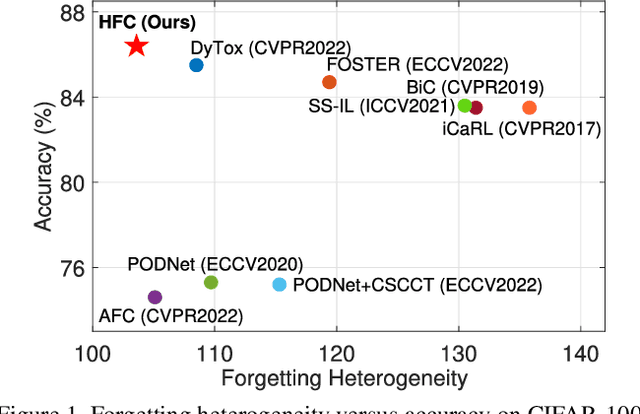



Abstract:Class-incremental learning (CIL) has achieved remarkable successes in learning new classes consecutively while overcoming catastrophic forgetting on old categories. However, most existing CIL methods unreasonably assume that all old categories have the same forgetting pace, and neglect negative influence of forgetting heterogeneity among different old classes on forgetting compensation. To surmount the above challenges, we develop a novel Heterogeneous Forgetting Compensation (HFC) model, which can resolve heterogeneous forgetting of easy-to-forget and hard-to-forget old categories from both representation and gradient aspects. Specifically, we design a task-semantic aggregation block to alleviate heterogeneous forgetting from representation aspect. It aggregates local category information within each task to learn task-shared global representations. Moreover, we develop two novel plug-and-play losses: a gradient-balanced forgetting compensation loss and a gradient-balanced relation distillation loss to alleviate forgetting from gradient aspect. They consider gradient-balanced compensation to rectify forgetting heterogeneity of old categories and heterogeneous relation consistency. Experiments on several representative datasets illustrate effectiveness of our HFC model. The code is available at https://github.com/JiahuaDong/HFC.
I3DOD: Towards Incremental 3D Object Detection via Prompting
Aug 24, 2023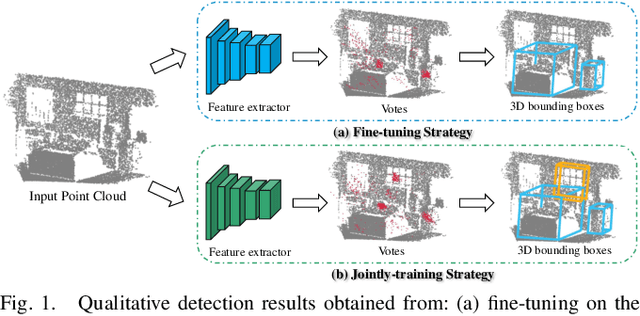
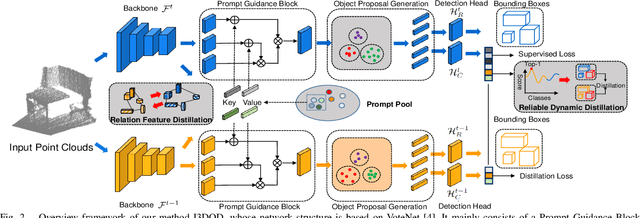

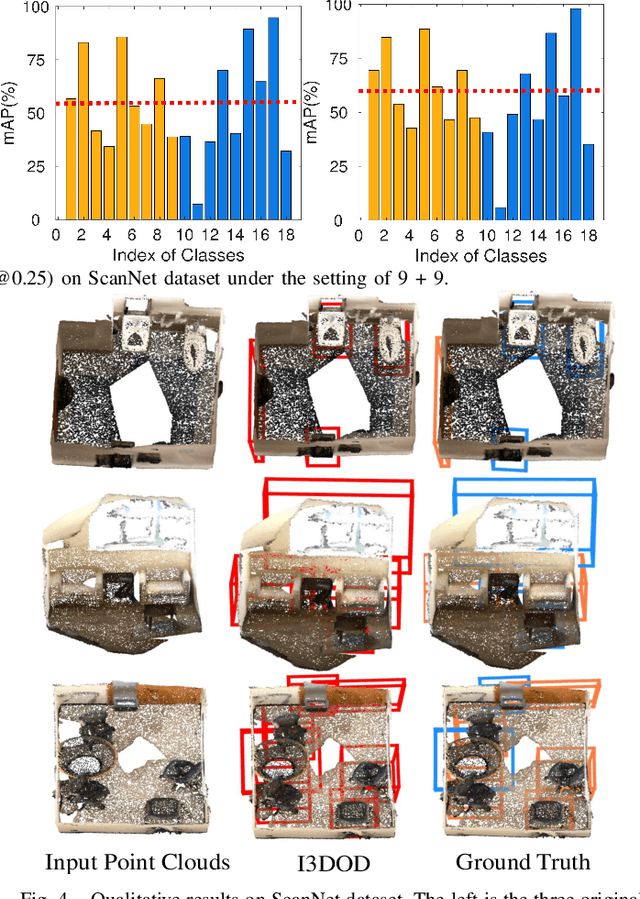
Abstract:3D object detection has achieved significant performance in many fields, e.g., robotics system, autonomous driving, and augmented reality. However, most existing methods could cause catastrophic forgetting of old classes when performing on the class-incremental scenarios. Meanwhile, the current class-incremental 3D object detection methods neglect the relationships between the object localization information and category semantic information and assume all the knowledge of old model is reliable. To address the above challenge, we present a novel Incremental 3D Object Detection framework with the guidance of prompting, i.e., I3DOD. Specifically, we propose a task-shared prompts mechanism to learn the matching relationships between the object localization information and category semantic information. After training on the current task, these prompts will be stored in our prompt pool, and perform the relationship of old classes in the next task. Moreover, we design a reliable distillation strategy to transfer knowledge from two aspects: a reliable dynamic distillation is developed to filter out the negative knowledge and transfer the reliable 3D knowledge to new detection model; the relation feature is proposed to capture the responses relation in feature space and protect plasticity of the model when learning novel 3D classes. To the end, we conduct comprehensive experiments on two benchmark datasets and our method outperforms the state-of-the-art object detection methods by 0.6% - 2.7% in terms of mAP@0.25.
Gradient-Semantic Compensation for Incremental Semantic Segmentation
Jul 20, 2023Abstract:Incremental semantic segmentation aims to continually learn the segmentation of new coming classes without accessing the training data of previously learned classes. However, most current methods fail to address catastrophic forgetting and background shift since they 1) treat all previous classes equally without considering different forgetting paces caused by imbalanced gradient back-propagation; 2) lack strong semantic guidance between classes. To tackle the above challenges, in this paper, we propose a Gradient-Semantic Compensation (GSC) model, which surmounts incremental semantic segmentation from both gradient and semantic perspectives. Specifically, to address catastrophic forgetting from the gradient aspect, we develop a step-aware gradient compensation that can balance forgetting paces of previously seen classes via re-weighting gradient backpropagation. Meanwhile, we propose a soft-sharp semantic relation distillation to distill consistent inter-class semantic relations via soft labels for alleviating catastrophic forgetting from the semantic aspect. In addition, we develop a prototypical pseudo re-labeling that provides strong semantic guidance to mitigate background shift. It produces high-quality pseudo labels for old classes in the background by measuring distances between pixels and class-wise prototypes. Extensive experiments on three public datasets, i.e., Pascal VOC 2012, ADE20K, and Cityscapes, demonstrate the effectiveness of our proposed GSC model.
Self-paced Weight Consolidation for Continual Learning
Jul 20, 2023


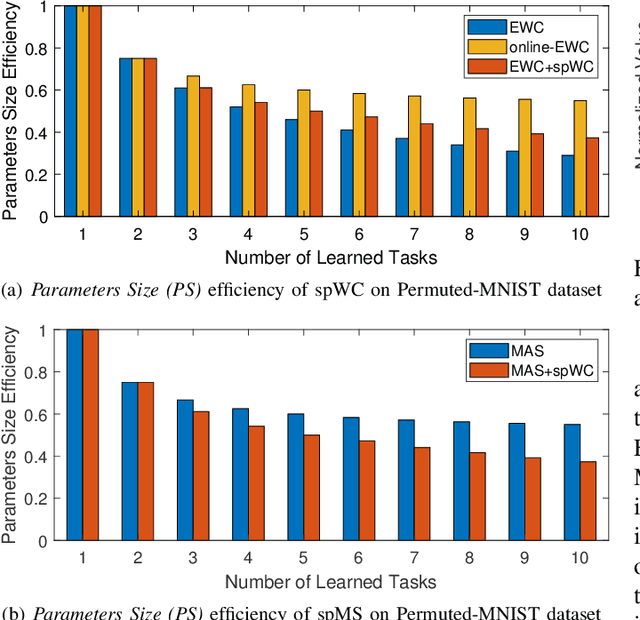
Abstract:Continual learning algorithms which keep the parameters of new tasks close to that of previous tasks, are popular in preventing catastrophic forgetting in sequential task learning settings. However, 1) the performance for the new continual learner will be degraded without distinguishing the contributions of previously learned tasks; 2) the computational cost will be greatly increased with the number of tasks, since most existing algorithms need to regularize all previous tasks when learning new tasks. To address the above challenges, we propose a self-paced Weight Consolidation (spWC) framework to attain robust continual learning via evaluating the discriminative contributions of previous tasks. To be specific, we develop a self-paced regularization to reflect the priorities of past tasks via measuring difficulty based on key performance indicator (i.e., accuracy). When encountering a new task, all previous tasks are sorted from "difficult" to "easy" based on the priorities. Then the parameters of the new continual learner will be learned via selectively maintaining the knowledge amongst more difficult past tasks, which could well overcome catastrophic forgetting with less computational cost. We adopt an alternative convex search to iteratively update the model parameters and priority weights in the bi-convex formulation. The proposed spWC framework is plug-and-play, which is applicable to most continual learning algorithms (e.g., EWC, MAS and RCIL) in different directions (e.g., classification and segmentation). Experimental results on several public benchmark datasets demonstrate that our proposed framework can effectively improve performance when compared with other popular continual learning algorithms.
 Add to Chrome
Add to Chrome Add to Firefox
Add to Firefox Add to Edge
Add to Edge